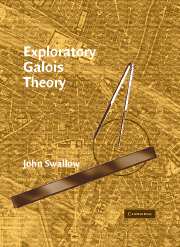Book contents
- Frontmatter
- Contents
- Preface
- Introduction
- 1 Preliminaries
- 2 Algebraic Numbers, Field Extensions, and Minimal Polynomials
- 3 Working with Algebraic Numbers, Field Extensions, and Minimal Polynomials
- 4 Multiply Generated Fields
- 5 The Galois Correspondence
- 6 Some Classical Topics
- Historical Note
- Appendix: Subgroups of Symmetric Groups
- Bibliography
- Index
Appendix: Subgroups of Symmetric Groups
Published online by Cambridge University Press: 06 July 2010
- Frontmatter
- Contents
- Preface
- Introduction
- 1 Preliminaries
- 2 Algebraic Numbers, Field Extensions, and Minimal Polynomials
- 3 Working with Algebraic Numbers, Field Extensions, and Minimal Polynomials
- 4 Multiply Generated Fields
- 5 The Galois Correspondence
- 6 Some Classical Topics
- Historical Note
- Appendix: Subgroups of Symmetric Groups
- Bibliography
- Index
Summary
The Subgroups of S4
There are eleven conjugacy classes of the 30 subgroups of S4, as follows:
(1) {〈0〉}, the class consisting of the single subgroup of order 1.
(2) The class of all subgroups of order 2 that are generated by a single transposition, that is, subgroups of the form 〈(ij)〉 for distinct i and j. This class has six elements.
(3) The class of all subgroups of order 2 that are generated by the product of two disjoint transpositions, that is, subgroups of the form 〈(ij)(kl)〉 for distinct i, j, k, and l. This class has three elements.
(4) The class of all subgroups of order 3. These are generated by a 3-cycle and take the form 〈(ijk)〉 for distinct i, j, and k. This class has four elements.
(5) The class of all cyclic subgroups of order 4. These are generated by a 4-cycle and take the form 〈(ijkl)〉 for distinct i, j, k, and l. This class has three elements.
(6) The class of all subgroups of order 4 isomorphic to the Klein 4-group ℤ/2ℤ ⊕ ℤ/2ℤ that are generated by two transpositions. These subgroups have the form 〈(ij), (kl)〉 for distinct i, j, k, and l. This class has three elements.
(7) {〈(12)(34), (13)(24)〉}, the class consisting of the unique subgroup of order 4 isomorphic to the Klein 4-group ℤ/2ℤ ⊕ ℤ/2ℤ that is generated by two products of two transpositions.
(8) The class of all subgroups of order 6. These have the form 〈(ijk), (ij)〉 for distinct i, j, and k. This class has four elements.
[…]
- Type
- Chapter
- Information
- Exploratory Galois Theory , pp. 197 - 200Publisher: Cambridge University PressPrint publication year: 2004

